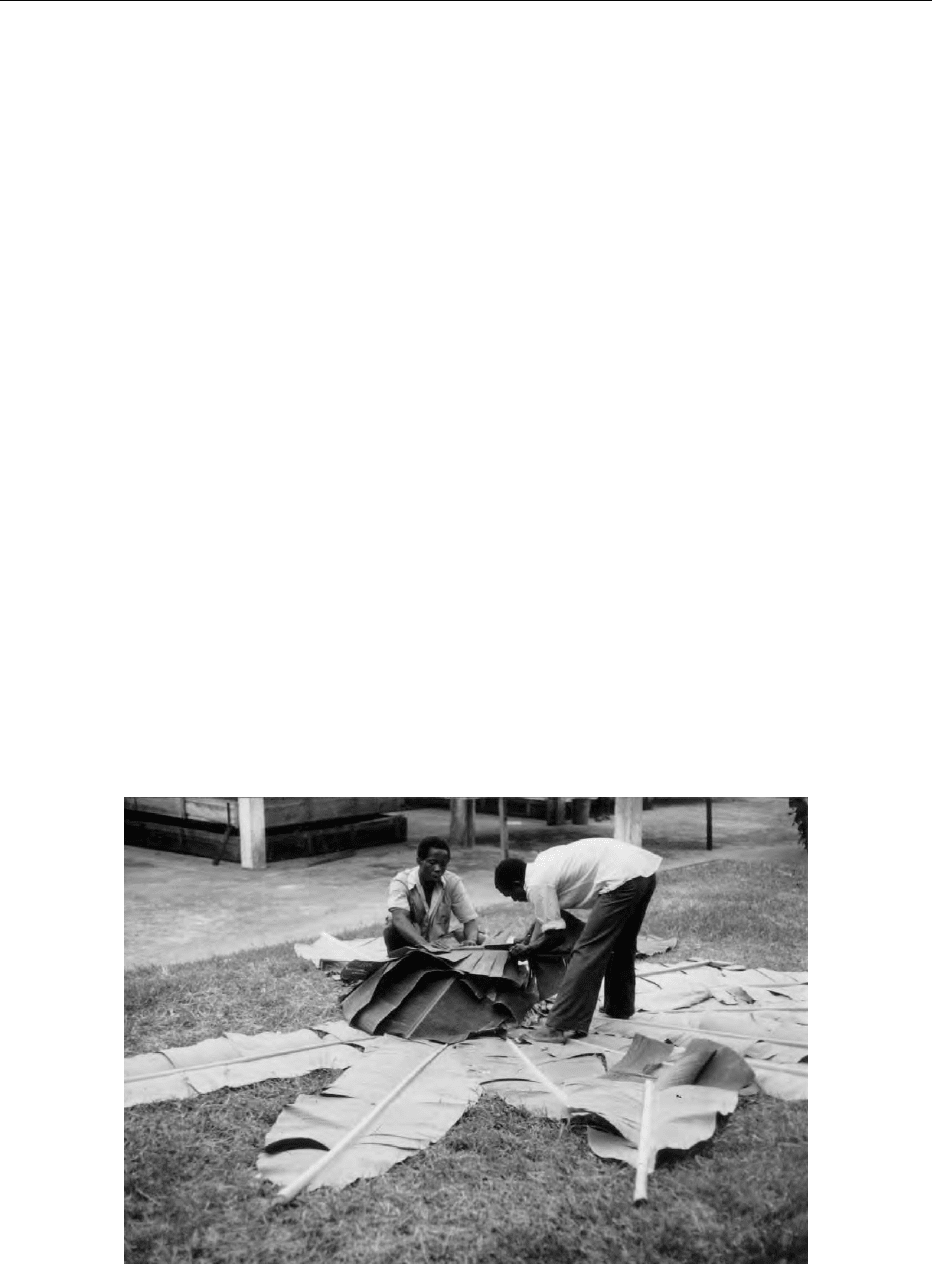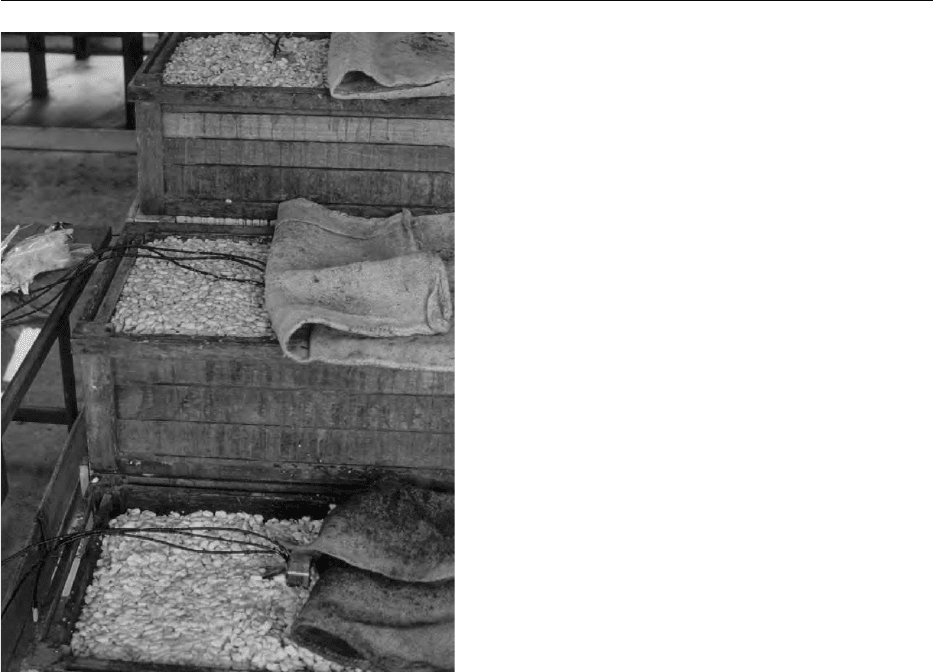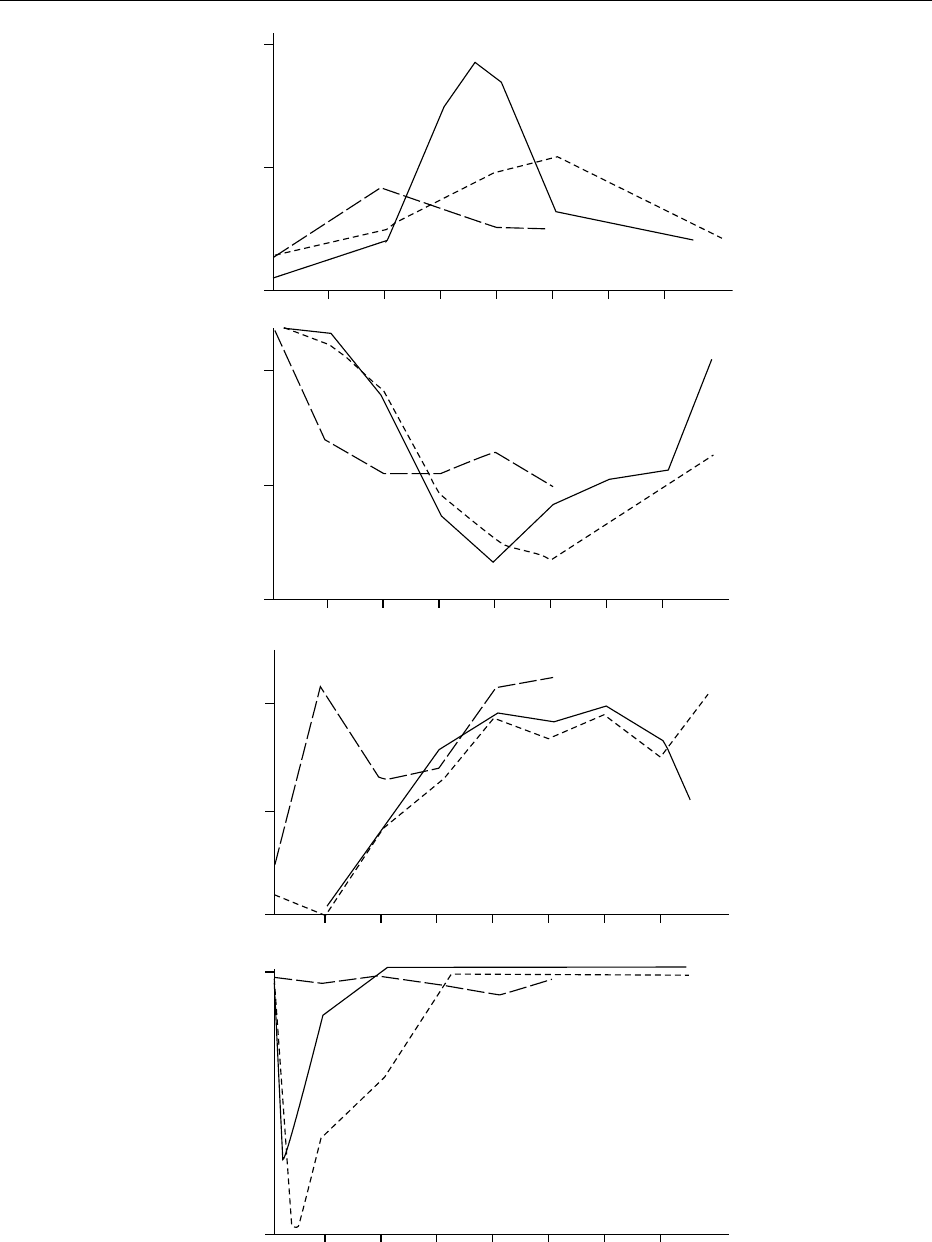Caballero B. (ed.) Encyclopaedia of Food Science, Food Technology and Nutrition. Ten-Volume Set
Подождите немного. Документ загружается.


such as abundant aldehydes and alcohols, as well as
of aroma-damaging substances like volatile phenols,
are also removed. As a result the typical and slightly
volatile aroma becomes more pronounced.
0057 Sorption phenomena of aroma materials at particle
surfaces of the heterogeneous chocolate mass of fat
and fat-free portions have considerable influence on
the flavor.
0058 Thin-layer treatment of cocoa mass During modern
chocolate processing the cocoa liquor is degassed
before being put into the chocolate recipe. By using
special equipment, degassing can be performed more
effectively than in the conche. Thin-layer vaporizers
are generally used, which may shorten the remaining
conching time considerably. The process conditions
have to be coordinated with the quality of the cocoa
liquor, so that the valuable aroma is not removed
together with the more volatile unknown materials,
thereby flattening the taste of the product. A reduc-
tion of 10–30% of acids and low-boiling compounds
seems to be optimal.
0059 Alkalization of cocoa Alkalization (‘Dutching’)is
mainly used to intensify the color, to modify the flavor,
and to improve the dispersability of cocoa powder in
water or milk. In this process, beans, nibs, or mass are
treated with solutions or suspensions of alkali, usu-
ally potassium or sodium carbonate, sometimes hy-
droxides or ammonia. The permitted maximum is
generally 2.5–3 parts of potassium carbonate (or
equivalent alkali) per 100 parts of cocoa. The pH
of a natural cocoa is about 5.5, whereas the pH of
commercially available Dutch process cocoas will fall
between 6.8 and 8.0.
0060 Color and flavor changes during alkalization are
mainly based on modifications of polyphenolic sub-
stances. Dutch processing results in a milder and
altered flavor, and a darker color. Under alkaline
conditions, soluble monomeric flavonoids (mainly
epicatechin) are oxidized and condensed to give poly-
mer tannins. Red and brown pigments are developed
and the astringency is reduced. Volatile acids are
partially neutralized.
Cocoa Aroma Analysis
0061 The cocoa aroma volatiles only occur in milli- or
microgram per kilogram quantities. They are dis-
solved in the fat phase or physically bound to a
heterogeneous matrix of constituents of differing
polarity. Isolation and enrichment techniques are
necessary to obtain the flavor volatiles in sufficiently
high concentrations. Distillation methods, head-
space techniques, and extractions, or combinations
of these techniques are used. The separation of the
volatiles is performed by means of capillary gas chro-
matography (GC) or high-performance liquid
chromatography (HPLC). (See Chromatography:
High-performance Liquid Chromatography; Gas
Chromatography.)
0062Isolation and Analytical Techniques 0062
Extraction Extraction techniques have several dis-
advantages (time-consuming and the possibility of
introducing artifacts) but have the advantage of quan-
titatively isolating volatiles independent of their
boiling points. Usually, cocoa is defatted with petro-
leum ether and the residue is extracted with a polar
solvent such as water, ethanol, acetonitrile, ethyl
ether, or subcritical carbon dioxide. By means of
extraction, specific high-boiling compounds have
been isolated from cocoa: diketopiperazines, pyrones,
amines, amides, aromatic acids and phenols (these
compounds are mainly for subsequent GC separ-
ation), and theobromine, caffeine, and monomeric
flavonoids (for HPLC measurement).
0063Distillation Most of the known aroma volatiles
have been isolated from cocoa by means of distillation
(steam distillation, vacuum condensation, simultan-
eous steam distillation–extraction (SDE), head-space
enrichment). Nonvolatile impurities can thus be
avoided and a defatting step is not necessary, but
high-boiling compounds are partially lost and one
has to be aware of possible reactions during the heat
treatment.
0064The aqueous distillates are usually extracted with
small portions of ethyl ether for performing GC or
may be injected directly into an HPLC system.
0065Table 6 shows typical volatiles of roasted cocoa.
The flavor chromatograms of different cocoas are
rather similar, but the quantitative distribution of
the single constituents and their total amounts vary
distinctly with origin, fermentation, drying, roasting,
degassing, alkalization, or conching. Distillates of
chocolate contain similar compounds in lower con-
centration and altered distribution.
0066Analysis of indicative compounds and key odorants
Objective analytical data are necessary to relieve the
industrial quality control of time-consuming sensory
tests. For that purpose suitable indicators are needed
to evaluate the flavor. Several examples of indicative
compounds in cocoa aroma follow, together with
methods suitable for their estimation (GC; HPLC;
ultraviolet (UV) detector; electrochemical detector
(ELCD)): Fermentation degree – epicatechin
(HPLC–ELCD), tetramethylpyrazine (GC or HPLC–
UV); flavor-grade cocoas linalool (GC); roasting in-
tensity ratios of 2,5-dimethyl- to tetramethylpyrazine
1446 COCOA/Chemistry of Processing

or trimethyl- to tetramethylpyrazine (GC or HPLC–
UV), ratio of 5-methyl-2-phenyl-hex-2-enal to 2-phe-
nylethanol (GC), dihydrohydroxymaltol (GC or
HPLC–ELCD–UV); intensity of degassing of cocoa
masses – 3-methylbutanal (head-space GC).
0067Aroma extract dilution analyses (AEDA) is a potent
tool to screen the most odor-active compounds in
foods. The application of AEDA on the cocoa volatiles
revealed about 40 main odorants in cocoa mass.
Sensory Evaluation
0068Sensory evaluation is extremely important for cocoa
process control and for the quality assurance of cocoa
and chocolate products. Based on a tasting panel,
which consists of trained and selected members, dif-
ferent sensory tests (flavor profile, difference, and
scoring tests) are used and the results are statistically
evaluated. (See Sensory Evaluation: Taste.)
0069The flavor profile test This test is essential to obtain
an assessment of the development of taste and flavor
within the mouth as a result of individual sensory
perceptions. The varying intensities of the specific
characteristics are observed and evaluated. An evalu-
ation plan is used which considers the flavor and
texture characteristics and is completed by a numeric
scale. Some characteristics of cocoa mass are raw,
acid, flavorful, typical cocoa bitterness, burnt/bitter,
astringent, off-taste (cooked, moldy, smoky, ham,
chemical, etc.). In addition, descriptors for plain
chocolate are sweetness, aromatic, cocoa intensity,
harmonic, persistent, caramel, vanilla, off-taste (card-
board, metallic, rancid, etc.). Intensities range from 0
to 4: absent, barely perceptible, weak, medium,
strong. Texture descriptors are sticky/neat, coarse/
smooth, dry/mellow, snappy/soft. (See Sensory Evalu-
ation: Descriptive Analysis.)
0070Difference tests These are preference tests to com-
pare a sample against a control: in a simple form it is a
paired test or, with one sample duplicated, a triangu-
lar test. Preferences and the intensity of deviations are
reported. Triangular tests are used to check samples
which have slight deviations from the standard.
0071Scoring test This test is used for production quality
control and for assessing chocolate samples after
periods of storage under different conditions. Sensory
evaluation: 9–7, optimal to good; 6–4, satisfactory to
sufficient; 3–1, lacking to unsatisfactory. (See Sensory
Evaluation: Sensory Rating and Scoring Methods.)
0072Tasting method Solid cocoa masses are chopped
and tasted with a spoon. Cocoa powders are
tbl0006 Table 6 Selected aroma compounds identified in extracts of
roasted cocoas
Compound Concentration
range
3-Methylbutanal IV
2,3-Butandione III
3-Methyl-butan-1-oe IV
Acetone II
2-Methylpyrazine III
2,5-Dimethylpyrazine III
2,6-Dimethylpyrazine II
2-Ethylpyrazine I
2,3-Dimethylpyrazine II
Methyltrithiomethane I
2-Ethyl-5-methylpyrazine II
2-Ethyl-3-methylpyrazine II
Acetic acid V
Trimethylpyrazine III
Linalool oxide (cis-furanoid) I
2,5-Dimethyl-3-ethylpyrazine II
2-Furfural II
Linalool oxide (trans-furanoid) I
Tetramethylpyrazine IV
Pyrrole I
Benzyaldehyde III
Linalool II
2,5-Diethyl-3-methylpyrazine I
5-Methyl-2-furfural I
3-Methyl butanoic acid V
Phenylacetaldehyde IV
Acetophenone III
Furfuryl alcohol I
1-Phenylethanol I
2-Phenethyl acetate II
2-Hydroxy-3-methyl-2-cyclo penten-1-one
(cyclotene)
II
Guajacol I
Benzylalcohol II
2-Phenylethanol III
2-Phenylbut-2-enal III
2-Phenethylamine II
2-Acetylpyrrole III
4-Methyl-2-phenylpent-2-enal II
Phenol I
3-Hydroxy-2-methyl-4-pyron (maltol) II
4-Hydroxy-2,5-dimethyl-3-(2H)-furanone (furanol) III
5-Methyl-2-phenylhex-2-enal III
2-Pyrrolecarbaldehyde II
5-Methyl-2-pyrrolecarbaldehyde II
2,3-Dihydro-3,5-dihydroxy-6-methyl-4-pyrone
(dihydrohydroxymaltol)
IV
3,5-Dihydroxy-6-methyl-4-pyrone (hydroxymaltol) II
5-(2-Hydroxyethyl)-4 -methylthiazole III
1,2-Benzenediol III
Benzoic acid II
2-Phenylacetic acid IV
2-Phenylacetamide IV
Usual concentration range (mg kg
1
): I, <01; II, 01–05, III, 05–2; IV, 2–10;
V, >10. Succession of gas chromatographic retention times on a DB-wax
capillary column.
COCOA/Chemistry of Processing 1447

suspended to 10% in warm water, plain chocolates
are broken into pieces and tasted.
See also: Amino Acids: Properties and Occurrence;
Browning: Enzymatic – Biochemical Aspects; Caffeine;
Carbohydrates: Classification and Properties;
Chromatography: Gas Chromatography; High-
performance Liquid Chromatography; Cocoa:
Production, Products, and Use; Colorants (Colourants):
Properties and Determination of Natural Pigments;
Enzymes: Functions and Characteristics; Fatty Acids:
Properties; Lactic Acid Bacteria; Fats: Classification;
Sensory Evaluation: Sensory Rating and Scoring
Methods; Descriptive Analysis; Taste
Further Reading
Berbert PRF (1979) Contribuic¸a
˜
o para o conhecimento dos
ac¸ucares componentes da ame
´
ndoa e do mel do cacau.
Revista Theobroma (Brasil) 9: 55–61.
Biehl B, Heinrichs H, Ziegeler A, Berghausen H, Hammoor
M and Senyuk V (1993) The proteases of ungerminated
cocoa seeds and their role in the fermentation process.
Angewandte Botanik (Journal of Applied Botany) 67:
59–65.
Fincke A (1989) Analytische und technologische Entwick-
lungen auf dem Gebiet der Kakaoerzeugnissc. Lehens-
mittelchemie und gerichtliche Chemie 43: 49–55.
Forsyth WGC and Quesnel VC (1963) The mechanism of
cocoa curing. Advances in Enzymology 25: 457–495.
Hardy F and Rodriguez G (1953) Quantitative variations in
nitrogenous components of the cacao bean: effect of
genetic type and soil type. Annual Report on Cacao
Research, Imperial College of Tropical Agriculture
(Trinidad), 1945–51: 89–91.
Lehrian DW and Patterson GR (1983) Cocoa fermentation.
In: Rehm HJ and Reed G (eds) Food and Feed Produc-
tion with Microorganisms. Biotechnology, vol. 5, pp.
529–575. Weinheim: Verlag Chemie.
Martin RA Jr (1987) Chocolate. Advances in Food Re-
search 31: 211–342.
Oberparleiter S and Ziegleder G (1997) Amadori-Verbin-
dungen als Aromavorstufen in Kakao. Nahrung 41:
142–145.
Rohan TA (1963) Processing of Raw Cocoa for the Market.
FAO Agricultural Studies, no. 60. Geneva: Food and
Agriculture Organization.
Schnermann P and Schieberle P (1997) Evaluation of key
odorants in milk chocolate and cocoa mass by aroma
extract dilution analysis. Journal of Agriculture and
Food Chemistry 45: 867–872.
Schwan RF (1998) Cocoa fermentations conducted with a
defined microbial cocktail inoculum. Applied and Envir-
onmental Microbiology 64: 1477–1483.
Spencer ME and Hodge R (1992) Cloning and sequencing
of a cDNA encoding the major storage proteins of Theo-
broma cacao: identification of the proteins as members
of the vicilin class of storage proteins. Planta 186: 567–
576.
Voigt J and Biehl B (1995) Precursors of the cocoa-specific
aroma components are derived from the vicilin-class (7S)
globulin of the cocoa seeds by proteolytic processing.
Botanica Acta 108: 283–289.
Ziegleder G (1991) Composition of flavor extracts of raw
and roasted cocoas. Zeitschrift fu
¨
r Lehensmittel Unter-
suchung und Forschung 192: 521–525.
Ziegleder G and Biehl B (1988) Analysis of cocoa flavour
components and flavour precursors. In: Linskens HF,
Jackson JF (eds) Analysis of Nonalcoholic Beverages.
Modern Methods of Plant Analysis, new series, vol. 8,
pp. 321–393. Berlin: Springer-Verlag.
Production, Products, and Use
B Biehl, Technische Universita
¨
t Braunschweig,
Braunschweig, Germany
G Ziegleder, Fraunhofer Institut fu
¨
r Verfahrenstechnik
und Verpackung, Freising, Germany
Copyright 2003, Elsevier Science Ltd. All Rights Reserved.
Introduction
0001This article describes raw cocoa processing and the
nature, the technologies, and the use of cocoa powder
and chocolate. These are made from defatted and
nondefatted raw cocoa beans, respectively, which
come from the fermented seeds of the tropical tree
Theobroma cacao L. ‘Cocoa’ here is used as the over-
all term covering the finished products (cocoa
powders and chocolate), the semifinished product
(the raw cocoa beans), and the original seeds in the
pods on the tree.
0002Although cocoa products contain valuable nutri-
ents, their special nature lies in the unique flavor
which is not obtained from other plants. The unpro-
cessed seeds, however, do not have this desired flavor,
but instead an astringent unpleasant taste. Hence the
constituents expressed by the unique genetic potential
of the cocoa seeds are profoundly changed by pro-
cessing and production techniques, and these are
responsible for realizing or destroying the flavor po-
tential, as described in the previous article.
0003‘Processing’ covers all steps from harvesting the
pods up to the stage where the raw cocoa beans
come to the industrial manufacturer’s plant for ‘pro-
duction’ of the final goods.
Raw Cocoa Processing
General Outline
0004Processing usually includes the harvesting and break-
ing of the pods, extraction of the wet beans, transport
1448 COCOA/Production, Products, and Use

(of pods or wet beans), fermentation in covered heaps
or containers for some days, drying of the fermented
beans, sorting, grading, sacking, and storage. ‘Beans’
is a traditional term used commercially for seeds of
cocoa at any stage of their processing. Wet beans are
the seeds covered by the mucilaginous, sweet and
acidic pulp or its remainder during fermentation.
Raw cocoa beans are fermented and dried. The term
‘fermentation’ is used to describe the overall process
of heaping wet cocoa beans for several days, micro-
bial pulp degradation, and also endogenous postmor-
tem reactions, both enzymatic and nonenzymatic,
that take place in the seeds and which are induced
by pulp fermentation.
0005 At the cocoa plantations, fermentation and drying
may primarily be looked upon as a curing process in
order to stabilize the fresh beans by microbial degrad-
ation of the firmly adhering, perishable pulp, and by
drying.
0006 From this point of view the resulting qualities,
especially the flavor potential, may be subordinate
aspects. However, the quality is essential for subse-
quent manufacture of finished products. Raw cocoa
quality may vary considerably depending on the
manner of processing. First grades command an
extra premium. However, since grading takes into
account defects of raw cocoa, but not flavor inten-
sities or flavor notes, there is no way of providing an
extra premium for raw cocoa with superior flavor
potential. Certain raw cocoa origins are given prefer-
ence (and a higher price) by the industry and the
market in virtue of experienced quality differences
compared to less desirable origins.
Origin of Flavor Differences
0007 Some experts assume flavor differences to be due to
edaphic, climatic, or plant genetic particularities in
the cocoa-growing countries. However, these differ-
ences may partially or even predominantly be due to
traditional processing practices which are not uni-
form in the various producing countries.
0008 Soil nutrients and climate generally affect the
physiology of plants. Climatic changes have influence
on pod growth, seed size, the amount of seed con-
stituents, and thus on the starting material used for
cocoa processing. Apart from the variable response of
cocoa cultivars to climate, there is inadequate know-
ledge about the significance of genetic diversity of the
planted cocoa trees and harvested seeds with respect
to its influence on flavor quality. Criollo (fine) and
Forastero (bulk) raw cocoas reveal flavor differences
which are attributed to genetic influences. A huge
number of different genotypes and hybrids, derived
from one or both of these varieties and their forms, are
planted. During the last decade genotype-depending
flavors in raw cocoa beans have been reported which
were harvested from trees of different vegetative
clones and which were processed under empirical
standard conditions. Unequivocal conclusions are
complicated since flavor determinant constituents in
raw cocoa (like acids, catechins, and peptides) under-
went profound transformations during processing.
Physiological effects like variation of the seed’s indi-
vidual pulp layers also interfere. In the case of clonal
effects it is likely that flavor differences do not depend
on the genetic expression of the cotyledons (nibs), but
rather on the genotype of the vegetative tree control-
ling pod growth and the property of pulp and testa.
All vegetative parts of a cloned hybrid represent the
same genotype but the generative progeny, the
embryos, does not.
Practice of Fermentation
0009Handling and care during processing significantly
affect raw cocoa quality and flavor. To improve raw
cocoa quality, repeated attempts have been made to
modify the methods. Few met general application.
The different methods of cocoa fermentation are
mostly developed from local traditions under particu-
lar conditions in the various cocoa-growing coun-
tries. They will not be described in this article. The
reader is referred to earlier reviews cited below for
detailed and valuable information. Instead, repre-
sentative processing methods as practiced in Brazil,
Ghana, and Malaysia, variable courses of fermenta-
tion, and effective modifications will be described.
Most of the common practices correspond to the
description given in the following sections. Heap fer-
mentation and box fermentation as the prevailing
methods will be described briefly.
0010In both cases, ripe pods are harvested and the husks
are opened by means of a cutlass or wooden billet.
The wet seeds are removed from the husk and pla-
centa and are collected for transport. Abnormal,
black, infested or clustered beans and foreign matter
are removed. The wet cocoa is piled up in heaps or
boxes of variable capacity, allowing drainage of
sweatings through the bottom. Care is taken that
mixing can be carried out by turning the fermenting
cocoa upside down and inside out. The wet cocoa is
covered with banana leaves or jute bags and is left by
itself for 5–7 days, interrupted by one or more turn-
ings after 24, 48, or 72 h. After a given time, or
following an assessment of its appearance and odor,
the fermented cocoa is transferred to a drier.
0011Standardized methods, such as the heap and box
fermentations, are used at well-established farms or
estates but they are not in common use elsewhere.
Any kind of box or other receptacle such as troughs,
frames, baskets, boats, or bags can be found to serve
COCOA/Production, Products, and Use 1449

for curing widely varying quantities of wet cocoa.
Alternatively, the wet cocoa is left on the ground or
on a drying platform where a partial fermentation
may occur, depending on the depth of the layer, occa-
sional heaping, and weather conditions. These irregu-
lar types of curing probably play a subordinate role in
most of the raw cocoa-producing countries, but they
contribute to the nonuniform low-quality cocoas as
they appear on the market. However, some special
methods are used to produce high-quality cocoas, as
is reported from Ecuador, where in some estates the
wet beans are spread at day but heaped overnight.
This reminds us that cocoa fermentation is still basic-
ally an empirical procedure.
0012 Heap fermentation (Figure 1) The typical succes-
sion of microbial pulp degradation occurs whenever
wet cocoa is piled up for several days. Heap fermen-
tation is used in West Africa. The heap is prepared
outdoors on banana leaves layered on wooden sticks
to allow better drainage. The cocoa is covered by the
same leaves by folding up the peripheral ends in such
a way that rain is kept off. The amount of wet cocoa
(80–1000 kg) depends on the harvest. Due to the flat,
conical shape of the heap compared to boxes, the
bottom layer and the surface layer are large, which
promotes not only aeration but also cooling. Thus, at
least one turning after 48 h is necessary. The highest
temperature may normally be found 5 cm beneath the
surface.
0013Box fermentation (Figure 2) Boxes are placed under
roofs and are made from locally indigenous timbers.
They are jacked up and their bottom (sometimes also
the walls) are perforated to allow drainage. On large
plantations the fermentary would consist of batteries
of several open boxes (1.0 1.0 1.0 m) which facili-
tate turning from one box to the next. Alternatively,
long boxes (e.g., 10 m length) can be divided by
partitions. Depending on the harvest, the cocoa is
filled up to 100 cm in depth.
0014Compared to average-sized heaps (about 50–80 cm
top height), the deep box (100 cm) depth requires a
longer time for fermentation because of reduced aer-
ation (almost exclusively from the top).
0015In Malaysia, shallow boxes have been introduced
to overcome the lack of uniformity (see below and
Figure 2). Cascades of shallow boxes are used in large
estates, each of which may have a capacity of several
tonnes, but a height not exceeding 35 cm.
0111Revolving barrels which are provided with perfor-
ations for aeration and with some device for effective
mixing during gentle rotations allow quite uniform
fermentations. Aeration, pulp loss, and water evapor-
ation are significantly increased by frequent turnings.
Whether this is favorable or not depends on the ripe-
ness and constitution of the pulp.
Standard Course of Fermentation
0016The progress of fermentation is characterized by
visual changes and changes of odor. Most typical are
fig0001 Figure 1 Preparing a heap fermentation (Cocoa Research Institute of Ghana, Ghana). Reproduced from Cocoa: Production, Products
and Uses. Encyclopaedia of Food Science, Food Technology and Nutrition, Macrae R, Robinson RK and Sadler MJ (eds), 1993, Academic
Press.
1450 COCOA/Production, Products, and Use

color changes and the accumulation of a red sap in the
beans penetrating the shell when the beans die. The
internal appearance of dried beans taken at regular
stages from the fermenter also indicates the progress
of fermentation. Seeds appear slatey as long as antho-
cyanins have not yet been released from their intact
storage cells. After seed death they would dry to
compact beans, violet in color, with the shells sticking
strongly to the nibs. When fermentation is completed
the nibs would turn brown and the beans retain a
plump, porous structure, with a loosened shell. This
is the type of bean required for marketing. For
grading on the market, the internal appearance of
beans is taken to estimate the so-called ‘degree of
fermentation’ in a cut test. (See Colorants (Colour-
ants): Properties and Determination of Natural
Pigments.)
0017 After harvested pods have been broken, the
wet cocoa is inoculated by spores of an ubiquitous
range of airborne microorganisms. The course of
fermentation may be subdivided into four stages (I–
IV). The succession of events is generally as follows
(cf. solid line in Figure 3).
0018Stage I 0018
Pulp In the mucous, acidic (pH 3.5–4.0) pulp, an-
aerobic, microbial metabolism of sugar starts imme-
diately, with alcoholic fermentation first dominating
over the lactic acid fermentation. Pulp is drained off.
Carbon dioxide is produced and this displaces air
from the box. The odor changes from sweet fruits to
ethanol.
0019Seeds Most seeds at this stage are still alive (germin-
ation test).
0020Stage II 0020
Pulp As more pulp has been drained off and sugar
metabolized, less carbon dioxide is produced. Conse-
quently, more air is taken up by the pulp, giving rise
to oxidative formation of acetic acid, an exothermic
process heating up the cocoa from the ambient tem-
perature to 45–52
C. Aeration would now be ran-
domized and accelerated by turning. There is an odor
of acetic acid.
0021Seeds Both the temperature increase to > 45
Cand
the uptake of acetic acid kill the seeds. A maximum
level of acetic acid produced in the pulp is followed by
a maximum amount of acetic acid absorbed in the
beans. The average pH value in the nibs drops from
6.4 to 4.0–4.7. Oxygen is quantitatively consumed in
the fermenting pulp, keeping the nib under anaerobic
conditions and allowing postmortem reactions in the
absence of oxygen.
0022Stage III 0022
Pulp As acetic acid production slows down because
of exhaustion of substrate, bacterial oxidation of
acetic acid causes a slow increase in pulp pH. The
temperature may drop because of lack of substrates
and reduced microbial activity in the pulp, which is
still acidic (about pH 5.0). Lactic acid formation,
which has been suppressed during stage II, may in-
crease once more. The odor is still acidic but changes
to a bread-like impression.
0023Seeds Most of the postmortem enzymatic and non-
enzymatic reactions in the seeds are completed by this
time.
0024Stage IV 0024
Pulp Now, after pulp degradation, a buoyant air
flow from the bottom to the top of the hot cocoa
fig0002 Figure 2 Experimental shallow box fermentation (Malaysian
Agricultural Research and Development Institute, Malaysia). Re-
produced from Cocoa: Production, Products and Uses. Encyclo-
paedia of Food Science, Food Technology and Nutrition, Macrae R,
Robinson RK and Sadler MJ (eds), 1993, Academic Press.
COCOA/Production, Products, and Use 1451

0
0
0
1234567
1234567
1234567
123456
7
10
20
4.0
5.0
6.0
30
40
50
Acetic acid (nibs)
(mg seed
−1
)
pH (nibs)
Temperature (8C)
0
0
0
20
(a)
(b)
(c)
(d)
Oxygen (% saturation in the pulp)
Days
fig0003 Figure 3 Differences in the course of shallow box fermentations. Solid lines, well-aerated top layer; seeds from unstored ripe pods
(up to 8 days of fermentation). Dotted lines, less aerated middle layer; seeds from unstored ripe pods (up to 8 days of fermentation).
1452 COCOA/Production, Products, and Use

provides the beans with access to air. A second tem-
perature increase indicates a new aerobic microbial
activity on the shells, which will spread to the nibs if
drying is delayed.
0025 Seeds Stage IV seems to be important to insure
browning of the beans and to harmonize flavor
during subsequent drying. Although no experimental
explanation is available, it is probable that develop-
ing aerophilic organisms may now help to increase
shell permeability. (See Lactic Acid Bacteria.)
0026 Although this fourth stage cannot clearly be dis-
tinguished from the preceding one, it merits special
attention for correct termination of fermentation to
avoid subsequent overfermentation.
0027 Overfermentation subsequent to stage IV is charac-
terized by a steep increase in pH value, first at the
surface of the beans, and later in the nibs. It is
accompanied by a pronounced darkening or even
blackening of the beans and a characteristic hammy
off-flavor which persists in the raw cocoa to an extent
which depends on how severely this process took
place before drying. Overfermentation may be looked
upon as a direct aerophilic microbial attack on the
nibs, destroying the cocoa flavor potential. Depending
on the bean surface moisture at stage IV, the transi-
tion to overfermentation may be slow or very rapid.
Wet beans may turn black overnight and may evolve a
typical strong hammy off-flavor. It appears that the
oxygen concentration in the fermenting mass at this
stage is high enough for saturating respiration of
aerobes and microaerophilic organisms, but too low
for sufficient polyphenoloxidase-triggered browning
reactions which would impair microbial growth.
Variables in the Course of Fermentation
0028 Rate of fermentation The above description may
give the incorrect impression of a uniform process
running on a constant timescale. The stages described
in the previous section and illustrated in Figure 3,
however, are not bound to a fixed time but may be
considerably shorter or longer.
0029 The main reason is aeration: the more the wet
cocoa is aerated in stages I and II, the quicker the
temperature increases, the quicker the peak of acetic
acid appears first and decreases later on (solid and
dotted lines in Figure 3). These differences are
much more pronounced in deep boxes. The succes-
sion of events described is not changed. Wet cocoa
containing > 1.0 ml of pulp per seed would pass
through an ethanol fermentation even under con-
tinued aeration during stage I. In contrast, if no aer-
ation is allowed at stage I, the pulp of wet cocoa may
appear unchanged for several days. Lactic acid fer-
mentation would slowly acidify the seeds at a low
temperature. Later on, forced aeration at stages III
or IV causes a quick pH increase in the nibs.
0030Thus, if fermentations are terminated at a prefixed
time, e.g., after 6 days, the cocoa may be at stage III,
stage IV, or overfermented, revealing a low or a high
pH value in the nibs, respectively. In practice, aer-
ation is intensified by turning, batch size, type of
fermenter, and pulp volume per seed: the smaller the
batch size, the larger is the specific surface for air
uptake. The surface area is also influenced by the
type of fermenter. A small conical heap (e.g., 250 kg)
is much more aerated than a deep box (100 cm
depth). A shallow box (30 cm depth) helps to increase
surface aeration.
0031Nonuniformity in the course of fermentation Not
only variation in rates of fermentation but also local
differences in the fermenting heaps or boxes are due
to inhomogeneous aeration. This applies especially to
deep boxes. At stage I, oxygen is only accessible at the
surface layer, where the process is accelerated, while
the lower layers are still under a carbon dioxide at-
mosphere. The hot zone of pulp oxidation and acetic
acid production slowly moves down to the bottom. If
pulp volume is large and the cocoa is not turned, the
anaerobic, cold situation (stage I) in the bottom layer
may persist during the time the top layer goes through
stages I–IV. After drying, the bottom layer would
produce slatey or violet beans, whereas the top layer
would consist of properly fermented or overfermen-
ted brown beans. Turning after 24 and 48 h reduces
this inhomogeneity, but not enough to eliminate this
effect entirely. As shown in Figure 3, even in shallow
boxes acetic acid accumulation and consumption are
delayed in a less aerated middle layer compared to a
top layer. While this type of nonuniformity is found
during fermentation of wet cocoa beans with a fully
developed pulp layer, the situation may be different
with beans from overripe pods covered by a thin layer
of pulp. Too many turnings would reduce the capacity
of the pulp to fulfill the entire sequence of stages I–IV
and a premature overfermentation would result.
Additionally, beans in unturned, aerated niches of
Dashed lines, middle layer; seeds from ripe pods stored for 10 days (up to 5 days of fermentation). (a) Acetic acid in the nibs; (b) pH
values in the nibs; (c) temperature in the fermenting mass; (d) available oxygen between the beans. Fermentations were performed
with wet beans from Malaysian hybrids. Simplified curves: turnings in (a) after 44, 92, and 139 h; (b) and (c) after 67 and 120 h. Data
derived from Meyer B, Biehl B, Said M, Samarakoddy RJ (1989) Post harvest pod storage: a method for pulp preconditioning to impair
strong nib acidification during cocoa fermentation in Malaysia. Journal of Science and Food Agriculture 48: 285–304.
COCOA/Production, Products, and Use 1453

the batches in boxes or heaps may undergo abnormal
changes due to heat loss, drying out, or fungal attack.
0032 Effect of harvest and postharvest treatment on fer-
mentation and raw cocoa quality Controlled aer-
ation is helpful in overcoming nonuniformity but
does not help in avoiding strong nib acidification
(Figure 3). The minimal pH value in the beans during
enzymatic reactions at stage II is essential for the
formation of flavor precursors rather than the nib
pH when terminating fermentation. With a large
pulp volume per seed, an excess of aeration during
the first stages accelerates acidification, but does nei-
ther limit acetic acid production nor decrease of nib
pH values to less than pH 4.5 (Figure 3, solid line).
However, nib acidification is moderate if the pulp
volume per seed is small (Figure 3, dashed line).
0033 The composition and volume of the pulp depend
on pod ripeness at harvest and postharvest treat-
ments. Ten days of open-air postharvest pod storage
or several hours of bean spreading for pulp drying
after breaking the pods were found significantly to
reduce pulp volume, pulp water, and pulp sugar per
seed (Table 1). These methods are particularly helpful
prior to fermentation of small seeds with a strong
layer of pulp. Subsequent shallow box fermentation
proceeds with well-aerated pulp during stage I. Cor-
respondingly, there is an early steep temperature in-
crease, but the decrease of nib pH value and the
formation and accumulation of acetic acid in pulp
and nibs is considerably reduced (Figure 3). It is as-
sumed that early aeration of a thin pulp surface layer
enhances respiration of sugars by yeasts and reduces
alcoholic fermentation beneath the surface, in con-
trast to a voluminous pulp.
0034 The important pulp/seed relation depends on both
genetic and physiological parameters: large seeds bear
less pulp per seed surface area than small seeds. How-
ever, seed size does not only depend on genetics. Pods
and seeds may be considerably smaller than usual
when growing under adverse conditions, e.g., during
severe drought. Furthermore, the pulp-to-seed ratio is
significantly reduced during ripening. Large pulp
volumes per seed from unripe seeds cause badly aer-
ated slimy fermentations. In overripe pods the pulp
volume is reduced as with stored pods, leading to
well-aerated, rapid fermentations. Raw cocoa flavor
characteristics with particular origins may depend to
a large extent on these physiological stages of wet
cocoa due to local traditions in postharvest treat-
ments. In average, bean size and ripeness of pods
harvested in Malaysia or in Ghana are quite different.
0035Seasonal effects on fermentation and raw cocoa
quality are often due to these differences in the pulp.
In practice, it depends on the circumstances discussed
above whether or not pulp preconditioning is advis-
able.
0036Finally, if wet cocoa is exposed to rain, subsequent
fermentation may lack sugar for heating and acetic
acid production, and would proceed in an erratic way.
Drying
0037Enzyme-controlled browning reactions which do not
occur before drying are essential for quality.
0038For sun-drying, the beans are spread on the ground,
on mats or on wooden floors raised from the ground
and protected against rain. Care is taken to move the
drying cocoa. The layers of cocoa are made shallow
or high to regulate the time of drying. Five to seven
days are usually necessary to reduce the water content
to less than 7.0%, a limit for fungal growth. (See
Drying: Drying Using Natural Radiation.)
0039For artificial drying, wood fires or oil burners are
connected to a flue under a floor of closely spaced
slats. There are many devices of this type for passing a
stream of hot air, but not of smoke, through the layer
of cocoa beans. The industry rejects smoky beans but
the smell of smoke may be confused with a hammy
off-flavor of overfermented beans. On large estates,
different types of industrial driers are used for
tbl0001 Table 1 Changes in the pulp during pod storage and bean spreading
Wet beans Pulp volume
(ml seed
1
)
Pulp water
(g seed
1
)
Sucrose þglucose
(mgseed
1
)
e
Reducing sugars
(mgseed
1
)
f
Malaysia, ripe (from unstored pods)
a
1.19 + 0.14 0.95 + 0.12 121.3 + 57.1
Malaysia, ripe (from pods stored for 10 days)
b
0.74 + 0.06 0.58 + 0.05 39.9 + 5.4
Malaysia (from unstored pods after spreading)
c
0.46 + 0.06 0.34 + 0.12 79.2 + 32.3
Ghana, ripe (from unstored pods)
d
0.84 0.69 91.2
Ghana (from pods stored for 7 days)
d
0.55 0.41 68.6
Mean values and standard deviations from samples of
a
10 and
b
four experiments with 1000 pods each.
c
Samples from four experiments with 130 kg of wet cocoa, each of different ripeness, sun spreading and surface drying for several hours.
d
From one experiment with 10 pods each.
e
Estimated polarographically.
f
3,5-dinitrosalicylic acid method (Biehl B, Meyer B, Crone G, Pollmann L (1989) Chemical and physical changes in the pulp during ripening and post
harvest storage of cocoa pods. Journal of Science and Food Agriculture 48: 189–208).
1454 COCOA/Production, Products, and Use

effective, short-time drying. (See Drying: Theory of
Air-drying.)
0040 The first stage of drying should be effective in order
to avoid overfermentation or fungal growth on the
wet cocoa, if the internal pH value is high. At this
stage, there is no danger in using hot air (e.g., 100
C),
although the temperature of the beans should not
exceed 40–60
C. In a shallow layer of cocoa beans,
water evaporation will keep the beans cool. However,
hot air flow through a deep layer (10 cm) would
heat the beans excessively. After external dryness of
the beans has been attained, the second stage of
drying can be continued slowly to facilitate enzymatic
browning in the nibs and to allow moisture equilib-
rium in the beans from the wet core to the dry surface.
Artificial drying may be interrupted for a while by a
resting period. In a third stage, the cocoa should
effectively be dried to < 7.5% water (w/w), preferably
in a stream of warm (< 60
C) but not hot air.
0041 Rewetting, polishing, and drying raw cocoa are
practiced locally to improve the external appearance,
especially of moldy beans, but shell breaking and
reinfection of the nibs may result. Rewetting also
increases browning of violet beans.
0042 After drying, the raw cocoa is sorted by removing
flat, broken, externally moldy beans and foreign
matter and by sieving (in the case of nonuniform
bean size) to meet the quality standards. Locally,
batches from different origins may be blended to
reach the maximum percentage of the particular vis-
ible bean defects which are allowed in the official
grading system.
Storage
0043 Provided there are good storage conditions, properly
processed raw cocoa can be stored for years without
any unwanted, serious sensory or analytical indica-
tion of loss of quality or of spoilage. However, once
processed, raw cocoa usually travels a long way from
the tropical origin to the final manufacturing plant,
being subjected to several risks underway. These risks
are primarily water and high air humidity, insect
infestation, and consequences of improper process-
ing. (See Storage Stability: Parameters Affecting Stor-
age Stability.)
0044 In addition to general rules for storage in tropical
and temperate climates, the hygroscopy of raw cocoa
beans must be considered. Dry raw cocoa containing
< 7.5% water will not be attacked by fungi.
According to moisture absorption isotherms, this
bean moisture would not be exceeded at < 80%
relative humidity. However, at a high level of air
humidity, any reduction in air temperature (e.g.,
during shipping) would cause damage by water
condensation and mold growth. Residual humidity
from fast drying must be considered. Repeated mois-
ture determinations are necessary in every lot. Fungal
spores are ubiquitous. However, moldy beans
resulting from fermentation and drying increase the
danger of fungal growth at a critical level of moisture.
Thermophilic and xerophilic fungi such as Asper-
gillus glaucus, A. fumigatus, Penicillium spp. and
Mucor sp. have been found to occur during both
processing and storage. Internal mold is further facili-
tated on broken beans and on injured shells. Brittle
shells, particularly from overfermented or rewetted
cocoa, not only increase the danger of mold but also
increase the amount of broken beans during transport
and stackingof bags. (See Spoilage: Molds in Spoilage.)
0045Out of nine insect species listed by Rohan, four
were mentioned to be important threats to stored
raw cocoa in the tropics: Cadra cautella, Lasioderma
serricorne, Araecerus fasciculatus and Tribolium cas-
taneum. Ephistia elutella, the cocoa moth, is only
found in temperate climates. In tropical countries,
insects are controlled by fumigation of raw cocoa
using the gases methyl bromide or phosphine applied
to stacks of stored cocoa under a gas-proof and water-
proof polythene sheet for 1.5 h. The gas is then ex-
tracted by fans. The sheets are left to protect the cocoa
against uptake of moisture and insects. (See Fumi-
gants; Insect Pests: Problems Caused by Insects and
Mites.)
Production of Cocoa Powder and
Semifinished Products
Cocoa Products
0046Two products are derived solely from cocoa beans:
chocolate and cocoa powder. These products are
interrelated, and two intermediate products play an
important role – cocoa mass and cocoa butter. This
relationship is made clear in Figure 4. The system
Cocoa powder
600
Cocoa butter
600
Chocolate
3800
1200
600
Cocoa mass
1800
Cocoa beans
2100
Cocoa shell
Sugar
1800
Milk powder
800
fig0004Figure 4 Products derived from cocoa beans. The figures are
approximate and in 1000 tonnes. Reproduced from Cocoa: Pro-
duction, Products and Uses. Encyclopaedia of Food Science, Food
Technology and Nutrition, Macrae R, Robinson RK and Sadler MJ
(eds), 1993, Academic Press.
COCOA/Production, Products, and Use 1455
